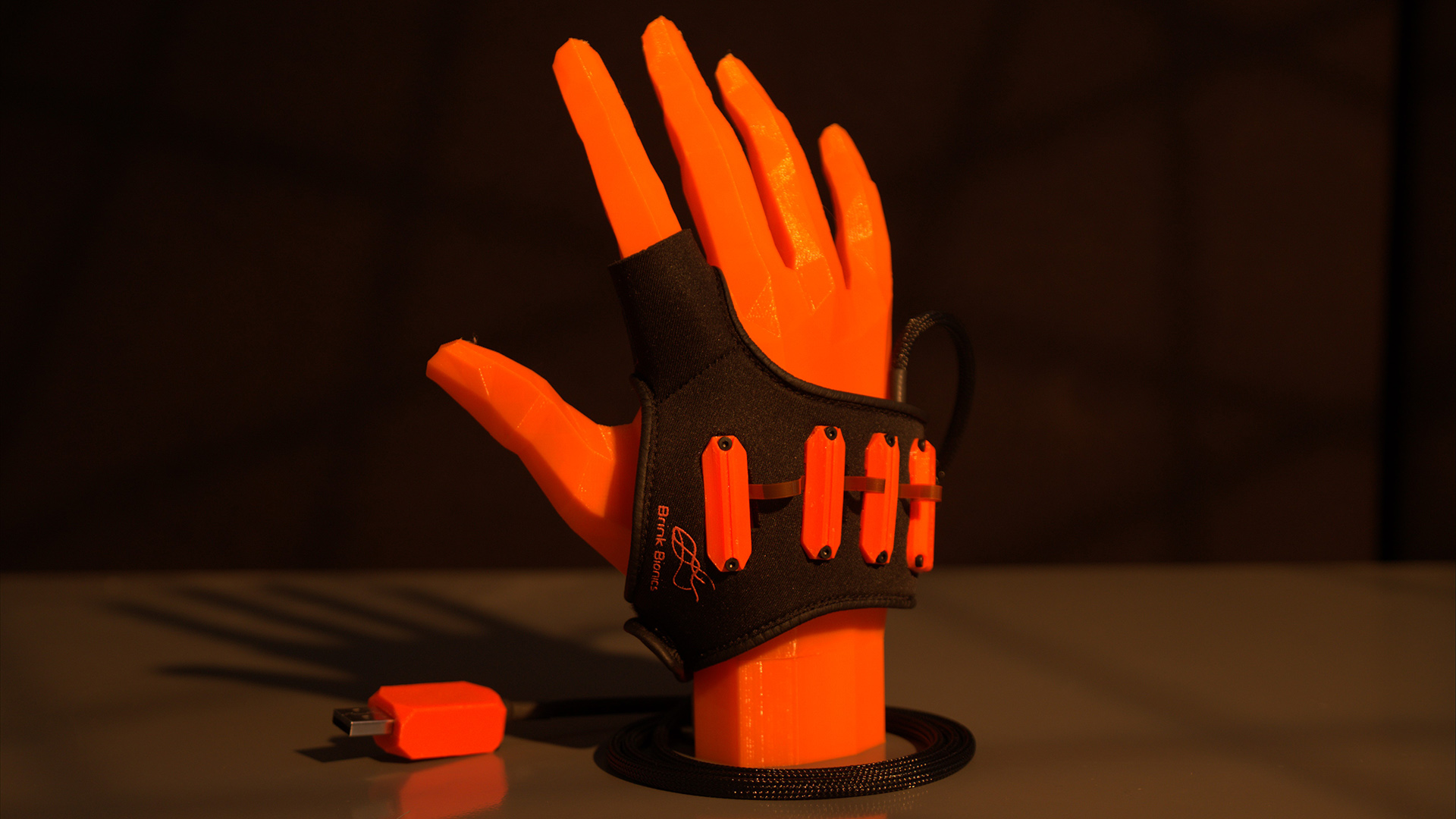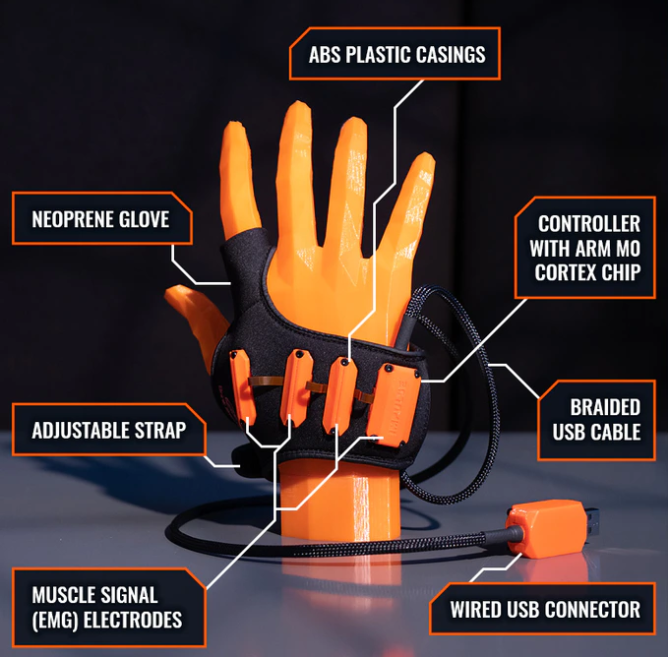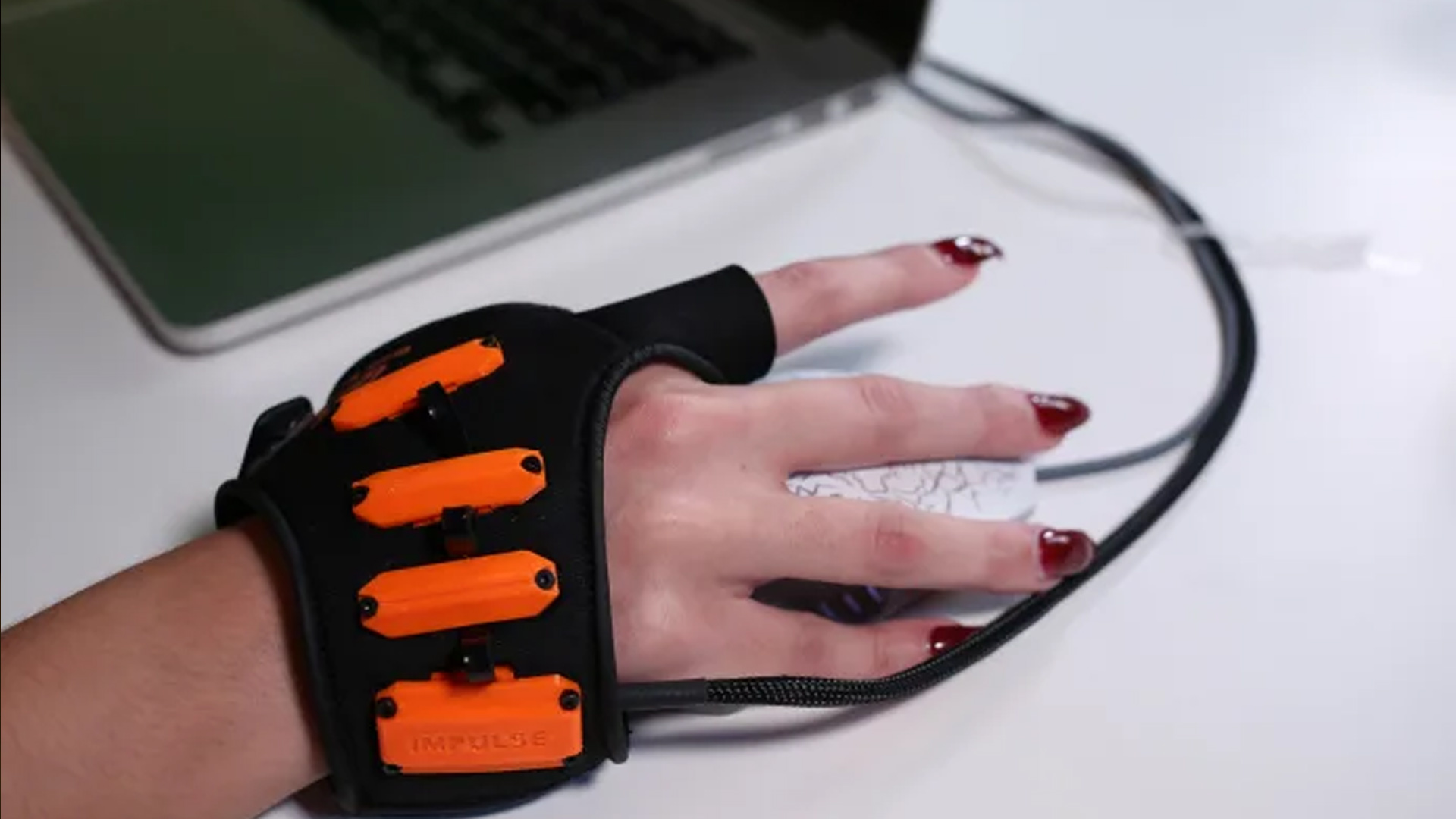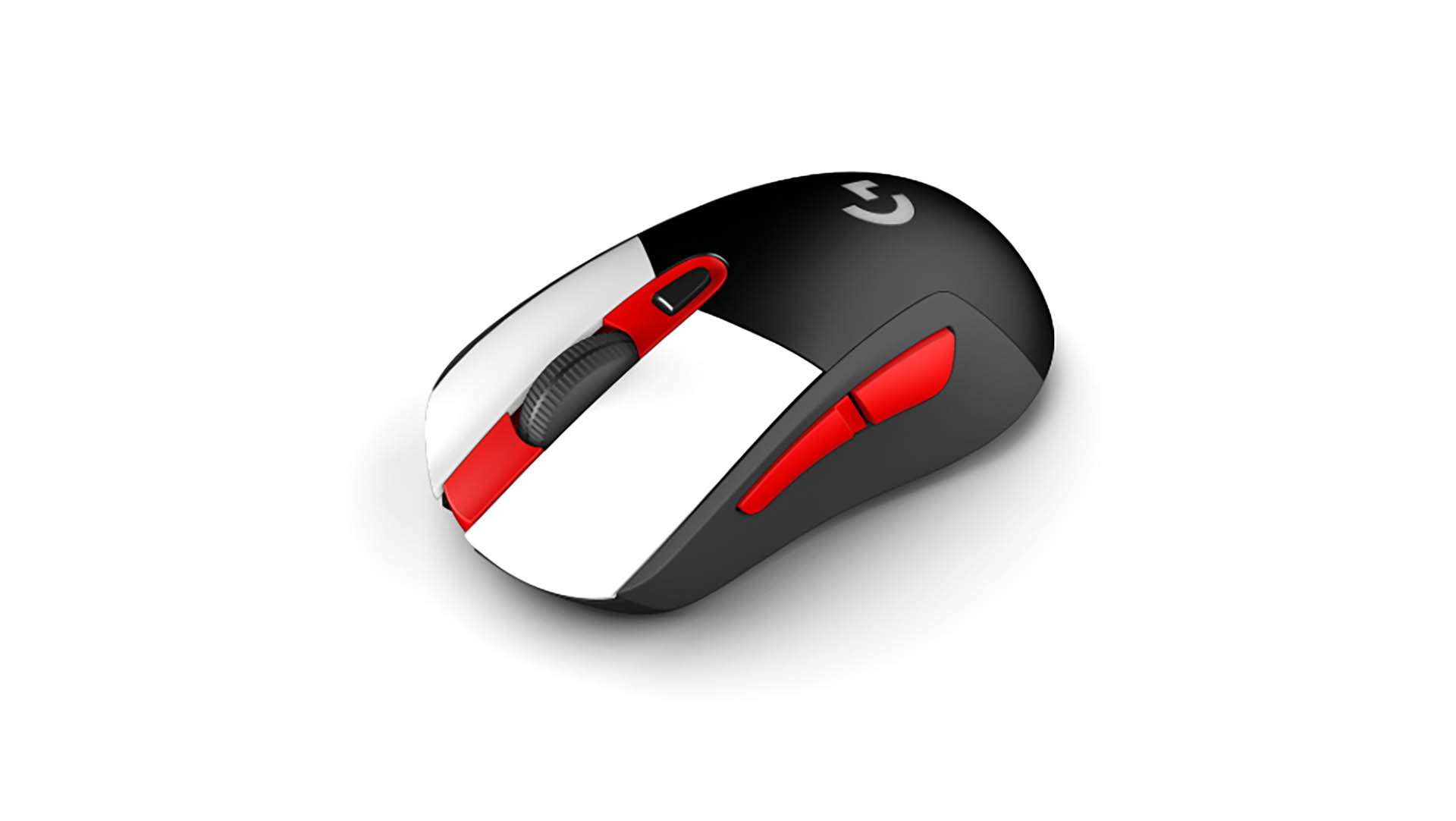Not quite Alyx Vance's, but this neuro-controller glove claims to make you a better gamer
We get a guided tour of the Impulse Neuro-controller: a glove that can cut input latency by 20ms or more.

PC gaming is just one big input/output circle: You see something, you react, your PC turns that into in-game action, you see something, you react… you get it. So much of PC gaming hardware is built to better accommodate that system and minimise latency between your brain and your game. But what if you could bypass some of that process entirely?
That's what Brink Bionics hopes to do with its neuro-controller, or neural mouse interface, named Impulse.
Simply described as a glove with a cable coming out of it, the Impulse is a device that hopes to reduce input latency between you and your PC while gaming. It's a product still in its infancy today, although Brink Bionics has units working alongside a fairly user-friendly app interface.
I spoke with company co-founder and CEO Erik Lloyd to discuss the technology behind the product, what it hopes to achieve, and when it might make it to market.
Admittedly, I also hoped to get an idea of whether Impulse actually works or not.
What we've developed are algorithms that can predict your movements and make decisions on whether you're doing certain mouse clicks with very, very little data.
Erik Lloyd, CEO, Brink Bionics
Usually a tech show would be prime spot for a practical technology showcase such as the neural mouse interface. Without it, we're stuck over video call and email. Yet even it proves mighty helpful in explaining what's going on when you slip on the glove—it might not work exactly how you imagine it to.
First off, it's back to basics on what the glove is actually measuring.
The biggest gaming news, reviews and hardware deals
Keep up to date with the most important stories and the best deals, as picked by the PC Gamer team.
"When you actively decide you're going to perform a movement your brain sends a signal down to your spinal cord," Lloyd tells me, "your spinal cord coordinates the complexities of muscle contractions into something called muscle synergies, which are complex interactions of muscles to perform a task, and then those signals all travel down to the necessary muscles to the different nerve fibres branch off your spinal cord, and they hit the muscles.
"And as soon as that signal reaches the muscle, there's an exchange of ions across the muscle membrane. And that's when you get a voltage signal, a tiny, tiny voltage potential across or along the muscle. And that's what we're measuring."

The glove itself is comprised of four sensors that measure the minute signal across the dorsal interossei, which are four muscles on the back of the hand that actually aid in the spreading of fingers and are integral to the depression movement of clicking a mouse switch through, what's known as, the MCP joint. These sensors are powered by an ARM M0 Cortex processor and connected via a USB cable that simply plugs into your PC.
Essentially, the glove takes a signal from a muscle in your hand, bypasses the muscle contraction and mouse input, and registers as a mouse click on your PC. It hopes to speed up the reaction times in games, when split-second movements and actions could make the difference.
"We eliminate that time delay by capturing the signal as soon as the sensor measures it, and relaying it right to your computer."
A mouse isn't actually required to actuate the neural glove and register a mouse click on your system, it's just an easy and repeatable way to generate the readable signal in a player.
Repeatable results are important due to noise, which is just as much a variable in human biology as an electrical system. Accurately tracking what is and isn't a mouse click from muscle movements, plenty of which will happen on a micro-level unbeknownst to a person, is the key to accurate readings and in preventing misclicks in game.
It's a problem most acutely felt when using electrochemical process measurements for gaming, Lloyd tells me, which has high standards for acceptable input lag.
Speaking to the difference between this system and others in the market today, Lloyd explains that "most of those technologies, their algorithms will require a certain amount of data gathered through time, before it can make a decision.
"So the algorithms will wait, collect data from your nervous system collect those electrical signals, for maybe anywhere from 50 to 100, or 300 milliseconds. And then it will make a decision after it's collected that much data. The problem is if your input has 200 milliseconds of delay waiting for enough data, that's like playing with a gaming mouse with a fifth to a quarter of a second of a delay, no one would use that for gaming. So what we've developed, or rather, what my co-founders have developed, are algorithms that can predict your movements and make decisions on whether you're doing certain mouse clicks with very, very little data."

Brink Bionic's system does require some training, at least, but as Lloyd demonstrates to me over the call, it doesn't take much time to get up-and-running with decent accuracy.
"Today, when you jump into the interface's short training process, we perform some clicks impulse learns what your muscles signals look like, related to when you're trying to click and then build a custom neural model based on you. From there, the user can tweak and adjust settings manually, with things like sensitivity to your neural signals, just like you would adjust your DPI sensitivity on your mouse."
So, does it work? I can't speak to the in-person experience—perhaps that's something we can revisit in 2022—but it appears to be in good working order with Lloyd at the helm over video call.
I get the guided tour of the user setup and interface, both of which seem simple enough on the surface, and the glove in action. It's clearly a work in progress, and the user interface requires some finessing, but the base functionality and building blocks of a workable product are all accounted for.
In practice, Lloyd shows me the ropes on his system. Measuring the difference in timestamp between the Impulse registered mouse click and the mechanical mouse click and the Impulse appears some 46 milliseconds faster. The click after that, 46 milliseconds faster, while the one following that comes in at 29 milliseconds. It's variable—Brink Bionics says the average is 30-40ms but it can dip below and peak around 80ms—but the Impulse glove is seemingly faster on all counts.

Best gaming mouse: the top rodents for gaming
Best gaming keyboard: your PC's best friend...
Best gaming headset: don't ignore in-game audio
I'm sure not everyone is going to want to wear a glove for gaming, and I'm a little worried about how you might go about keeping it clean, but a latency reduction of that size is sure to strike a chord with the competitive gaming scene. We're talking about a device that, at its worst, reduces input latency to a greater extent than Nvidia's Reflex technology. Although it'll be important to see how Impulse fairs across a wide range of games, and whether it gets the initial traction it needs to get off the ground.
Esports initially springs to mind as a potential hotbed for neurotech uses in gaming, and the company has just announced a new advisor has joined the team in esports owners Overactive Media's CEO, Chris Overholt. But just as swiftly do questions arise of fair play and what will be allowed in regards to neurotech and its use within competitive gaming. That's something Lloyd believes we'll be hearing a lot more about over the coming years.
"It's an unknown question at this point, neurotech and esports. It's already starting to draw some controversy in terms of what we're developing, and whether or not that would be allowed."
But there's hope for neurotech and esports yet, as Lloyd believes neurotech may have a bright future on the analytical side of play, as opposed to right there in the action.
"We're also want to explore how neural analytics can be used for esports teams as well. So not necessarily in competition as a real time controller, but as a means of analysing their neural data to see how they can improve their performance without Impulse," Lloyd explains.
Neurotech is something of a budding business in gaming today, and we've heard a great deal about potential neural controllers from even the likes of Valve's Gabe Newell and BCIs. Those are of a slightly different ilk to the electrochemical reaction that Brink Bionics is working on, as a BCI is harnessing the signal from the brain itself, but both share a common goal: changing how we physically interact with our games, and in doing so harnessing our biology more directly.
And if the Impulse Neuro-Controller is to be the future of competitive gaming, then we'll soon find out as more users get their hands on it. The Impulse Neuro-Controller was recently backed on Indiegogo and delivery is reportedly on track for a timely May arrival.
I'll admit I still have some reservations without taking it for a spin personally, but if it can deliver what it's been shown to today without too much hassle on a per game basis, it's surely going to get some gamers on the hook.

Jacob earned his first byline writing for his own tech blog. From there, he graduated to professionally breaking things as hardware writer at PCGamesN, and would go on to run the team as hardware editor. He joined PC Gamer's top staff as senior hardware editor before becoming managing editor of the hardware team, and you'll now find him reporting on the latest developments in the technology and gaming industries and testing the newest PC components.

